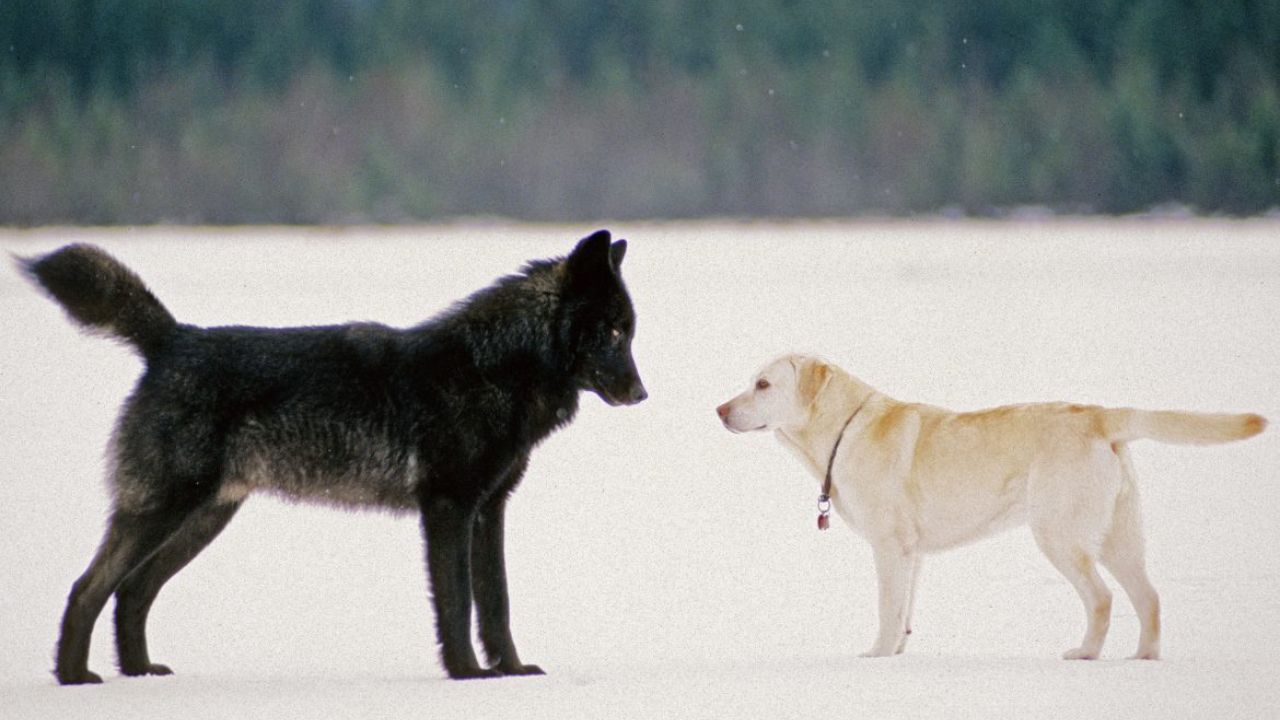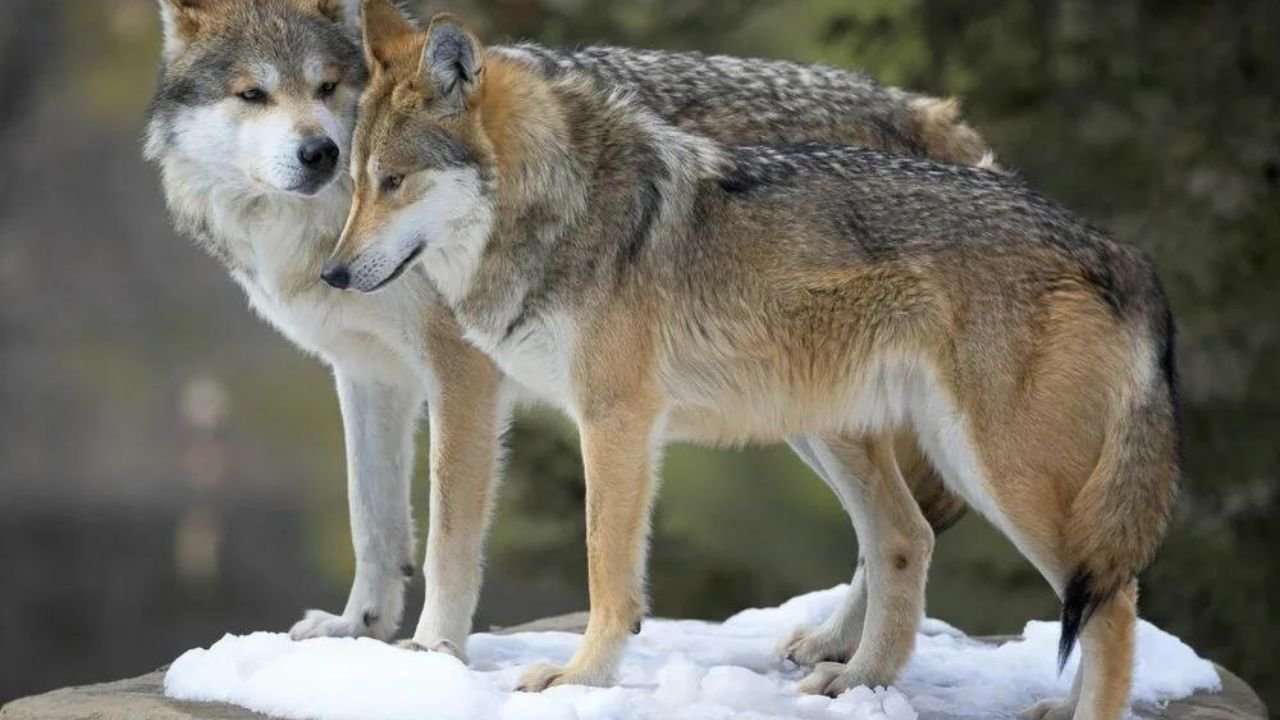Dogs have been our loyal companions for centuries, providing us with love, protection, and companionship. But have you ever wondered about the origins of these adorable creatures? In particular, are Pomeranians, with their small size and fluffy coats, related to wolves? Let’s delve into the fascinating world of canine evolution and explore the connection between Pomeranians and their wolf ancestors.
The Evolutionary Journey
From Wolf to Dog

To understand the connection between Pomeranians and wolves, we must trace back to their common ancestor – the gray wolf (Canis lupus). Scientists believe that dogs evolved from wolves through a process called domestication. This gradual transformation occurred over thousands of years as wolves began to interact and form mutually beneficial relationships with early humans.
The Domestication Process
Domestication involved selective breeding of wolves with specific traits that were favorable to humans. Over time, these wolves gradually developed unique characteristics that set them apart from their wild counterparts. Some key changes included a decrease in size, tamer behavior, and other physical and behavioral alterations.
The Emergence of Small Breeds
As domestication progressed, humans began selectively breeding dogs for various purposes, such as hunting, herding, guarding, and companionship. This intentional breeding led to the emergence of various dog breeds, including smaller ones like Pomeranians. These small breeds often retained some genetic traits from their wolf ancestors, despite their distinct appearance.
Pomeranians: A Spitz Breed
Pomeranians belong to the Spitz family, which includes breeds like Samoyeds, Huskies, and Malamutes. Spitz dogs are known for their thick double coats, curled tails, and pointed ears. These traits are believed to be inherited from their wolf ancestors, who adapted to survive in harsh climates.
Evidence of the Connection
Genetic Studies
Genetic research has provided significant insights into the relationship between wolves and dogs. Studies comparing the DNA of various dog breeds, including Pomeranians, have identified shared genetic markers with their wolf ancestors. These genetic similarities support the theory that Pomeranians and other domestic dogs share a common ancestry with gray wolves.
Physical Similarities
Despite the vast differences in appearance between Pomeranians and wolves, some physical characteristics suggest their evolutionary connection. Both species have similar skeletal structures, teeth shapes, and digestive systems. Pomeranians also retain some wolf-like behaviors, such as howling and digging, which further reinforce their ancestral link.
Behavioral Traits
Although Pomeranians have been selectively bred for their small size and friendly nature, they still exhibit some behaviors that harken back to their wolf ancestry. For example, Pomeranians, like wolves, are known to be highly territorial and protective of their owners and surroundings. This guarding instinct can be traced back to their wolf pack mentality.
The Importance of Understanding Ancestry
While it may seem trivial to ponder over the evolutionary origins of Pomeranians, understanding their ancestry contributes to our broader knowledge of canine evolution. It allows us to appreciate the rich diversity within the dog species and sheds light on the remarkable adaptability and plasticity of these animals.
Furthermore, studying the connections between domestic dogs and their wild ancestors helps us comprehend the behavioral and physiological differences among dog breeds. By recognizing these variations, we can enhance our understanding of breed-specific traits, temperament, and potential health concerns.
The Influence of Selective Breeding
Selective breeding played a crucial role in shaping the distinct characteristics of Pomeranians. As humans began domesticating wolves, they selectively bred them for specific traits that suited their needs. This intentional breeding resulted in the development of various dog breeds, each with its own unique set of physical and behavioral traits.
In the case of Pomeranians, their small size and fluffy coats were desirable traits that humans sought to enhance. Through generations of careful breeding, Pomeranians were selected for their diminutive stature and luxurious fur, which was often in stark contrast to the appearance of their wolf ancestors.
However, while the physical traits of Pomeranians may differ significantly from those of wolves, it is important to recognize that these traits are still influenced by their ancestral lineage. Underneath their adorable exterior, Pomeranians retain genetic predispositions inherited from their wolf ancestors, including aspects of their temperament and instincts.
The Role of Environment and Adaptation
As dogs evolved alongside humans, their environments changed drastically. Wolves that adapted to different habitats and climates gradually developed distinct features to survive in their respective ecosystems. These adaptations influenced the evolution of specific dog breeds, including Pomeranians.
Pomeranians, like other Spitz breeds, bear the influence of their ancestors’ adaptations to cold climates. Their thick double coats provide insulation against extreme temperatures, while their curled tails help protect their faces from snow and icy winds. These adaptations were necessary for wolves living in regions with harsh winters, and even though Pomeranians no longer face the same challenges, their physical traits serve as a reminder of their origins.
The Complexities of Ancestral Lineage
While it is clear that Pomeranians have a direct connection to wolves, it’s important to note that their evolutionary journey is not a linear progression. Domestication and selective breeding have led to significant genetic divergence between Pomeranians and their wolf ancestors. The extensive breeding programs conducted by humans have introduced variations and mutations into the genetic makeup of Pomeranians, creating a distinct breed with its own set of characteristics.
It is also worth mentioning that Pomeranians are just one among many dog breeds that share a common ancestry with wolves. Other breeds, such as German Shepherds, Huskies, and Malamutes, also exhibit traits inherited from their wolf ancestors. These breeds have varying degrees of physical and behavioral similarities to wolves, reflecting the diverse paths of domestication and selective breeding that shaped their evolution.
The Origins of Pomeranians
The origins of Pomeranians can be traced back to a region known as Pomerania, which is located in modern-day Germany and Poland. The breed gets its name from this region, where it was believed to have been developed through selective breeding.
Historically, Pomeranians were larger in size compared to the tiny dogs we see today. They were working dogs used for herding livestock, guarding properties, and even pulling sleds. Over time, these larger Pomeranians caught the attention of royals and nobles who sought to downsize them through selective breeding for companionship purposes.
The Influence of Queen Victoria
One of the key figures responsible for popularizing the smaller size of Pomeranians was Queen Victoria of England. Queen Victoria became enamored with the breed during her visits to Italy, where she encountered smaller Pomeranians. She began keeping them as pets and actively participated in breeding programs to refine their size and appearance.
Queen Victoria’s influence led to a shift in the breed’s standard, favoring smaller Pomeranians with luxurious coats and fox-like features. Her love for Pomeranians sparked a trend among the British aristocracy, and the breed’s popularity spread across Europe and eventually to the United States.
Modern Pomeranians
Today, Pomeranians are cherished as small companions and are known for their vibrant personalities and distinctive appearance. They typically weigh between three to seven pounds and stand at around six to seven inches tall. Their double coat consists of a thick undercoat and a longer outer coat that comes in a variety of colors.
Pomeranians are highly energetic and intelligent dogs. They require mental and physical stimulation to prevent boredom and have a tendency to bark when they feel threatened or excited. Despite their small size, they are known for their feisty and confident nature.
Pomeranians have gained popularity on social media platforms like Instagram, where their adorable looks and playful antics captivate a global audience. Many Pomeranian influencers have amassed large followings, showcasing their dogs’ unique personalities and stylish outfits.
Conclusion
Pomeranians and other domestic dogs have indeed evolved from wolves. Although Pomeranians may appear vastly different from their wolf ancestors, they share a common lineage and possess genetic, physical, and behavioral traits that link them to the gray wolf. Pomeranians, with their small size, fluffy coats, and endearing personalities, may appear worlds apart from their wolf ancestors.
Yet, they share a profound evolutionary connection that cannot be denied. Through an intricate process of domestication and selective breeding, Pomeranians have emerged as a unique breed while still retaining genetic ties to their wild roots.
FAQ
Are Pomeranians Wolves?
Pomeranians are energetic, devoted, little lap dogs with fluffy coats. Do Pomeranians have wolf ancestry? Beyond their current existence as a companion, Pomeranians have a rich past. Like other members of the canid family, grey wolves, foxes, and dingoes are the ancestors of all domesticated dogs.
What is a Pomeranian Dog?
The Pomeranian dog breed, also referred to as a Pom or Pommy, is a Spitz-type dog breed that gets its name from the Pomerania region in Central Europe, which spans north-west Poland and northeast Germany.
What is a Pom Dog?
In England, the Pomeranian, a breed of dog, was created and named after the Pom. The Pomeranian, sometimes referred to as the Wolf dog, did not gain widespread popularity in England until the 18th century, when members of the English monarchy began to show an interest in the breed.
Are Wolves and Dogs the Same?
To this day wolves and domestic dogs share many of the same behaviors and DNA. Pomeranians are descendants of Canis Lupus or Grey Wolves. The very earliest domesticated dogs were more like dingos or “domesticated” wolves compared to the many dog breeds we know today. The Pomeranian in particular are descendants of Ancient Spitz dogs.

